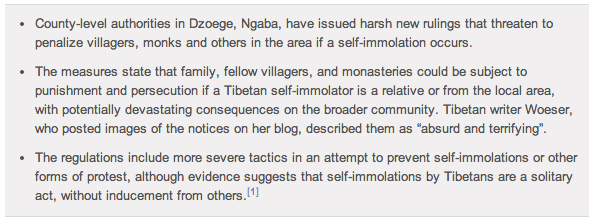Young Tibetan husband sentenced to death penalty for ‘homicide’ after death of wife in self-immolation protest in Ngaba
- Name: Dolma Kyab (Chinese: 卓玛嘉)
- Age: 32
- Status: Sentenced to Death
- Crime: “homicide”
On 16 August 2013, Chinese State media (Xinhua) reported that the Intermediate People’s Court in Ngaba sentenced Dolma Kyab, 32, to death for ‘killing his wife and burning her body to make it look as if she had self-immolated.’ Full details of the circumstances of Kunchok Wangmo’s death are not known. The imposition of the death penalty is rare in Tibet and there are concerns that the verdict may have been influenced by political circumstances.
Xinhua reports, “The court found that at 11pm on 11 March, Drolma Gya choked his 29-year-old wife Kunchok Wangmo to death with a scarf in their apartment in Dzoge County following an argument over his drinking.” The Xinhua report also stated that Dolma Kyab “burned the body because he believed an apparent self-immolation would help him cover up the crime, as well as preserve his dignity and that of their daughter.”
The only evidence given about this case is a ‘confession’ by Dolma Kyab. It is known that torture is frequently used to extract confessions in China, and that Tibetan prisoners are often tried secretly behind closed doors without legal counsel of their own choosing.
According to Chinese law, the case must now be reviewed by a higher court. If a first trial by an intermediate people’s court hands down the death penalty, the first appeal is conducted by a High People’s Court and also by the Supreme People’s Court. The higher courts have the power to change the verdict, including to impose a death sentence suspended for two years, which generally means life imprisonment. If the death penalty is upheld without reprieve, the execution is generally carried out shortly afterwards.
An editorial on 3 December 2012 in the Gansu Daily stated that the Ministry of Public Security, Supreme People’s Court and Supreme People’s Procuratorate had jointly issued ‘Opinion on Handling Cases of Self-Immolation in Tibetan Areas According to Law’, criminalizing various activities associated with self-immolations, including “organizing, plotting, inciting, compelling, luring, instigating, or helping others to commit self-immolation,” each of which may be prosecuted as “intentional homicide.” According to the Opinion, the motive of self-immolators is “generally to split the country,” and the act itself constitutes criminal behavior, as it poses a threat to public safety and public order. The Opinion states that “ringleaders” will be targeted for “major punishment.”
Source: International Campaign for Tibet


